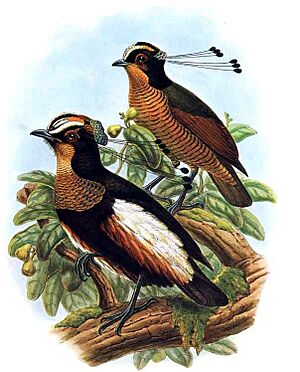Queen Carola's six-wired bird-of-paradise facts for kids
Quick facts for kids Carola's parotia |
|
|---|---|
 |
|
| Conservation status | |
| Scientific classification | |
| Genus: |
Parotia
|
| Species: |
carolae
|
The Carola's parotia (also called Queen Carola's six-wired bird-of-paradise) is a special type of bird-of-paradise. These birds are known for their amazing colours and unique dances. You can find them living in the mid-mountain forests of central New Guinea.
These beautiful birds mainly eat fruits and small creatures like arthropods (think insects and spiders). The male birds perform a stunning dance to attract females. This dance was first described in detail in 2006. It's a bit like the dance of another bird, Lawes's parotia, but changed to show off their shiny throat feathers and fluffy side feathers.
The bird was named after Queen Carola of Vasa. She was the wife of King Albert I of Saxony. Her husband also had a bird named after him, the King of Saxony bird-of-paradise.
Even though they live in remote areas, Carola's parotias are quite common. Because of this, they are listed as a species of "least concern" by the IUCN Red List of Threatened Species. This means they are not currently in danger of disappearing. They are also listed in Appendix II of CITES, which helps control their trade.
Contents
What Does Carola's Parotia Look Like?
Carola's parotias are medium-sized birds, growing up to about 26 centimetres (10 inches) long. The male and female birds look very different.
Male Carola's Parotia
The male Carola's parotia is very striking. It has a velvety black head with a shiny, coppery-bronze glow. On its head, it has a short, black crest that can stand up. Its eyes are surrounded by bright, iridescent (shining with many colours) gold feathers.
One of the most amazing features of the male is the six long, wire-like feathers behind its eyes. There are three on each side, and they have small, flat tips. Its body is mostly velvety black with a coppery shine. The male also has a special "breast shield" of large, scale-like feathers. These feathers can look intensely green, yellow, magenta, or pink, depending on the light.
Underneath, the male has blackish-brown feathers with a shiny copper look. It also has a large patch of soft, white feathers on its sides that curve inwards. The male's eyes are bright yellow, its beak is black, and its legs are blackish-grey.
Female Carola's Parotia
The female Carola's parotia is smaller than the male and has a longer tail. She does not have the fancy head plumes or the bright, shiny feathers of the male. Her feathers are mostly brownish to grey-brown.
She has light stripes on her face, including above her eyes and on her cheeks. Her upper body and tail are brown. Her wings have some reddish-brown areas. Her throat is lighter, and her belly has dark brown stripes. The female's eyes can be pale grey, cream, or yellow.
Young Carola's Parotias
Young male Carola's parotias look like adult females at first. As they get older, they slowly start to grow the colourful feathers of the adult male. Their tail also becomes shorter as they mature.
Different Types of Carola's Parotia
There are a few different types, or "races," of Carola's parotia. They are all similar but have small differences. For example, some might have slightly longer head plumes, or their feathers might be a darker black. Females also vary slightly in their face markings and how bright their colours are.
Behaviour and Life Cycle
We don't know everything about the Carola's parotia's life, but we do know that the males have very complex ways of attracting mates. These birds are polygynous, meaning one male mates with many females.
Courtship and Mating
Male Carola's parotias create special display areas on the ground, which are spread out in a "lek" system. A lek is a place where males gather to perform for females. During their display, males do many things:
- They crouch down.
- They flex their white side feathers.
- They hop around.
- They show off their colourful breastplates.
- They shake their special head plumes.
- They spread their side feathers out like a "tutu."
- They flutter their wings.
Many females might watch a male's performance. Some females might be interested, while others might go look for a different male.
Reproduction
Like most other female birds-of-paradise, the female Carola's parotia takes care of all the nesting and raising of the young birds by herself. We don't have exact details about their breeding habits yet. Sometimes, this species has been known to breed with another bird, the Lophorina superba, creating hybrid offspring.
Where Do Carola's Parotias Live?
Carola's parotias are found in different parts of New Guinea. Scientists have identified several subspecies, each living in a specific area:
- Parotia carolae carolae: Found in the Weyland Mountains and Wissel Lakes region in western New Guinea.
- Parotia carolae chalcothorax: Lives in the Doorman Mountains, south of the Idenburg River in western New Guinea.
- Parotia carolae chrysenia: Found on the northern side of the Central Cordillera, including areas like Lordberg and Hunstein Mountains, and possibly the Schrader Range and Bismarck Range in eastern New Guinea.
- Parotia carolae clelandiorum: Lives from central New Guinea southeast, possibly to the southern watershed of the Eastern Highlands.
- Parotia carolae meeki: Found in the Snow Mountains, from east of the Wissel Lakes and south of the Doorman Mountains, extending east to central New Guinea.


